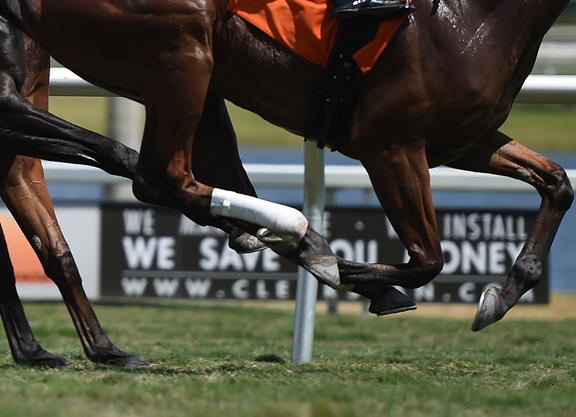By Bill Finley
That the most important racetracks in the U.S. working together to make the sport safer is a monumental achievement for an industry that has always been dysfunctional: the key players more interested in what's good for them than the sport. For that reason, the formation of The Thoroughbred Safety Coalition is to be celebrated for what it is, noteworthy progress toward solving the sport's most vexing problem, equine safety.
Yet, Tuesday's announcement left many questions unanswered and some areas of concern were not addressed. Let's hope those behind the Safety Coalition see it as a work in progress and that even more reforms than those that were announced are on the table. Let's hope they realize that racing's problems cannot be solved overnight or with the mere creation of just one more alphabet organization.
For now, they are off to a good start. With the Breeders' Cup, Churchill Downs, Del Mar, Keeneland, NYRA and the Stronach Group on board as founding members, the coalition has the backing of all of the sport's most important racetracks. That sends a potent message to the sport's critics that the industry is intent on making the game safer and will work feverishly to accomplish that goal.
Some of the reforms are common-sense practices that fall under the no-brainer category. Bisphosphonates and the stacking of non-steroidal anti-inflammatory drugs and corticosteroids will no longer be permitted at coalition tracks. Necropsies must be performed on all fatally-injured horses. Every track should employ a safety steward. These are easy and obvious fixes.
The meatier reforms, the ones that show that the coalition means business, include voided claims, out-of-competition testing and the requirement that private vets must share with regulatory officials what treatments or exams have been administered to a horse.
Allowing owners and trainers to void a claim if they find that their acquisition is infirm will reduce the incentive for people to drop an unsound horse in class hoping that it will be taken off their hands. Out-of-competition testing is the one reform that addresses the problem of cheating. It can't be done enough. Requiring vets to share their information with regulators won't win over any friends among vets and trainers, but it will bring transparency to what too often is a shadowy process. So will the creation of an electronic veterinary reporting system and centralized database.
That's what we know. What we don't know is every bit as significant.
What happened to the same tracks calling for a phasing out of Lasix? That was a central theme the first time the coalition tracks were heard from in April. The process was going to start with the elimination of Lasix in 2-year-old races in 2020 and then in graded stakes in 2021, meaning the 2021 Triple Crown would be held without the anti-bleeding medication. In a lengthy press release announcing the formation of the coalition, not one word was devoted to Lasix.
Shouldn't something had been said about shockwave therapy? It is a controversial practice and something that has largely been unaddressed.
Are additional tracks and organizations on board or just the ones who affixed their names to Tuesday's announcement? The April announcement that laid the groundwork for the coalition also listed Lone Star, Remington, Los Alamitos, Oaklawn, Tampa Bay Downs, Thoroughbred Owners & Breeders Association (TOBA) and the Kentucky Thoroughbred Association as being part of the reform effort. Are they or are they not part of the Thoroughbred Safety Coalition? And what about tracks that have never been mentioned, like Parx, the Penn National tracks, Woodbine, Hawthorne, etc? Will their arms be twisted to join the effort?
What does the industry plan to do about horse slaughter and ensuring that all retired race horses are ensured a safe and humane retirement?
What does this mean for the Horse Racing Integrity Act? With the formation of the safety coalition, will support for the HRIA wane? Will key components of the industry see the Thoroughbred Safety Coalition, and not the HRIA, as the right direction to go in order to enact meaningful change within the sport? The Jockey Club has been pushing hard for the HRIA and was conspicuously absent from the groups throwing its support behind the safety coalition.
What is the time line for implementation of these new steps and won't many of the changes require approval by state racing commissions? How easy will that be to accomplish?
Just where does the whipping of horses stand? The Thoroughbred Safety Coalition's website tells us that “The riding crop…can be used as a way to encourage horses or correct their direction (e.g., a tap to the shoulder signifies to a trained horse to move away from that tap, which can help avoid cutting off other horses, collisions, etc.)” Forgive me if I am missing something, but the wording is vague and I don't know what it means.
The racetrack executives quoted in the announcement did address the idea that there is more work to be done.
“There is no single solution and we are committed to finding the right answers, wherever that may lead us,” said Bill Thomason, President and CEO of Keeneland Association Inc.
Said NYRA CEO and President David O'Rourke: “We look forward to advancing these efforts, communicating directly with the public and broadening the coalition in the coming weeks and months.”
That's encouraging, a sign that the coalition members realize the sport's problems are broader than what the group has so far addressed. But they have to start somewhere. As long as this is the first step and not the last, Tuesday was a good day for the sport.
Not a subscriber? Click here to sign up for the daily PDF or alerts.






